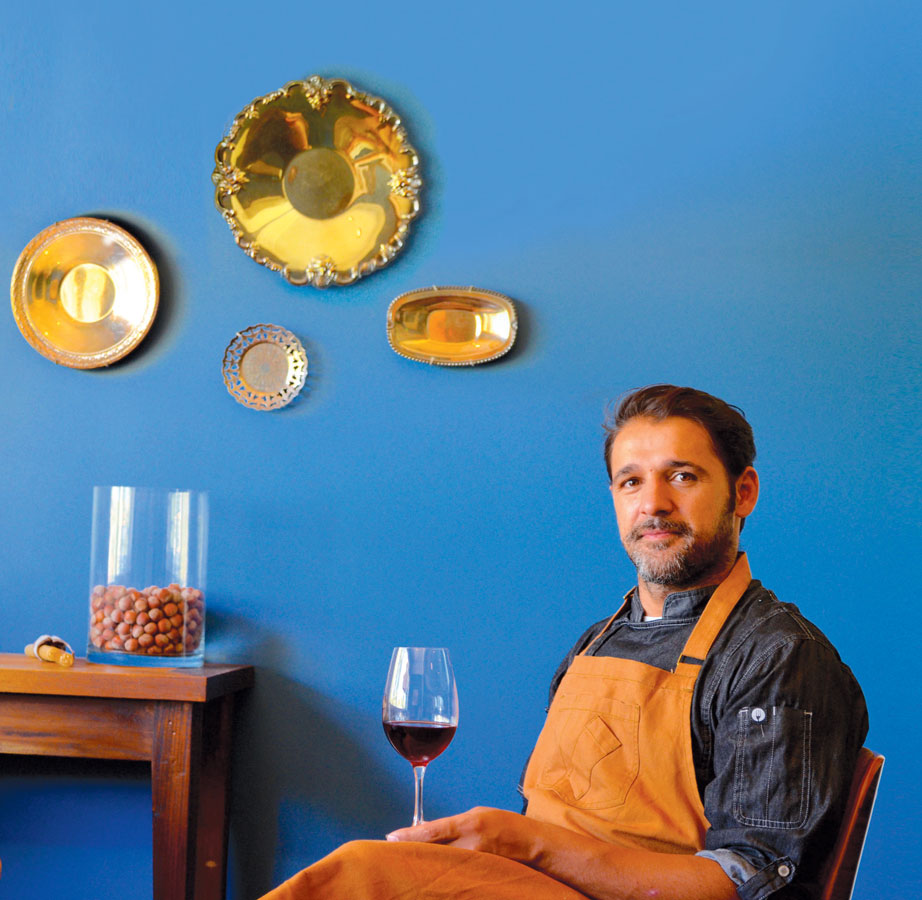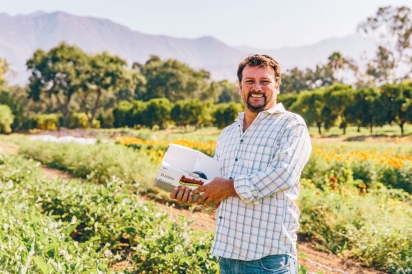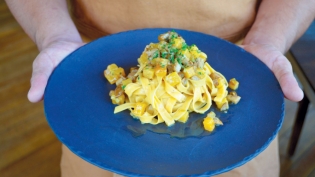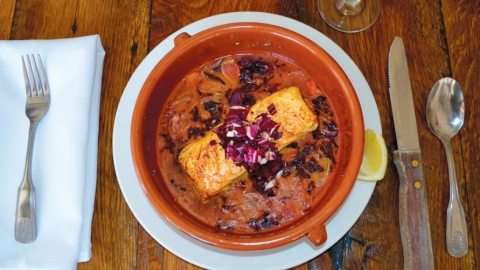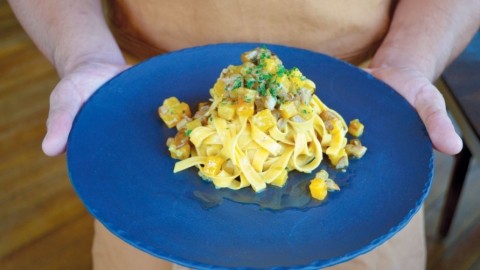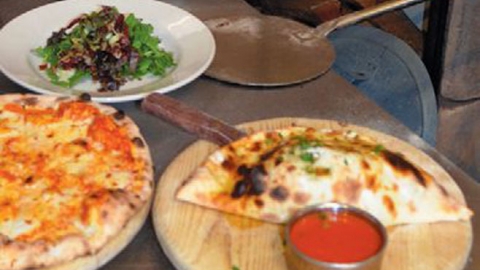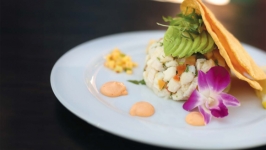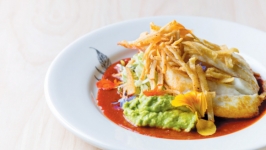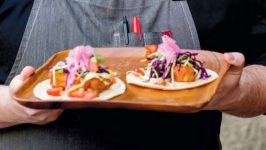Ojai Chefs Honor Italian Roots
For two Italian-born chefs, re-creating the flavors of home in Ojai is a family affair
Last summer I made a return visit to Italy, a trip I’d always wanted to take with my daughters before they went off to college. I wanted to share the experience of walking through cobblestone streets, to linger at an outdoor café late into the evening, to see firsthand the works of Michelangelo and to stroll among ancient Roman ruins.
Most of all, I wanted them to experience the food.
During our stops, the best meals were at quaint family-run establishments. The dishes they served were not ordinary fare: silky zucchini flan with fried zucchini blossoms and besciamella sauce; ravioli served over a creamy sauce of smoked eggplant; or penne with Chianti sauce. These were dishes worthy of a four-star restaurant, served with simplicity and without pretense.
What came through was the freshness of the produce, the complexity and intensity of flavors that these simple ingredients produced and the commitment to putting out a superior product.
As our trip wound down, we ate more thoughtfully and deliberately, savoring every bite and committing it to memory, knowing that these taste experiences would not be easily replicated at home.
My search for Italian food that measures up to what we experienced in Italy led me to two little gems run by Italian-born chefs who, with their spouses, have made Ventura County their home: Osteria Monte Grappa and Nocciola, both in Ojai and dedicated to combining the flavors and techniques of their homeland with local, seasonal ingredients.
It was this approach to cooking that brought Chef Stefano Bernardi to Ojai and to the 2009 opening of Osteria Monte Grappa, a Northern Italian restaurant focused on local ingredients and well-suited for animated conversation and lively gatherings.
Bernardi was born in the northern town of Castelfranco Veneto, and came to California as a young boy. He remained connected to his roots, thanks to trips to Italy every summer as soon as school let out.
Running restaurants was also in his blood. “My grandmother was in the hospitality business in Italy so we picked up where we left off when we came to Santa Barbara. The first restaurant was called Via Veneto,” he says. “My brother, Pietro, later sold it and started Pane e Vino. I worked with him until we opened another Pane e Vino in San Francisco, where I became the general manager.”
It was at one of his brother’s restaurants back in Santa Barbara that Bernardi met his future wife and business partner, Tammy. “We started a family and during that time we enjoyed going to Ojai. We would fantasize about opening a place of our own.”
Bernardi, who was already frequenting local farmers’ markets to get produce for the restaurants, found Ojai to be the ideal place to break out on his own. “We felt that the Ojai Valley was perfect for us. It has a small-town feel, good for raising a family and perfect for a restaurant because it was near all the farms.”
He stops at local farms every morning before heading to the restaurant, adjusting the menu depending on what’s in season.
“If you go to most good restaurants in Italy you’ll eat what’s in season in that place. Ojai really opened a lot of possibilities to do that. I change items on my menu every day, and I’m driving to go farther and farther in that direction. Even though those ingredients are not very Italian, the approach is very Italian.”
They also get heartier with their meats during this time of year, he adds. “We’ll get lamb and goat from Jimenez Farms [in Santa Ynez Valley]. I like to braise the lamb and serve it over fresh pasta and mint pesto, topped with a sheep’s milk feta.”
Wild-foraged mushrooms are one of Bernardi’s favorite fall ingredients. “We forage wild porcini and chanterelle mushrooms when in season. Ventura County has a good amount of chanterelles when it rains,” he explains. “We’ll normally get porcinis from Central California and do so many different things. Before the drought started there were so many available, which is very typical in Italy.”
He serves them raw in carpaccio, drizzled with olive oil and greens like cress or arugula on top with a little lemon. He also loves putting them on pizza in the restaurant’s wood-burning oven and grilling them served with a little bit of polenta, he says.
“Southern California chanterelles are bigger and meatier than almost any other place in the world,” Bernardi says, adding that he likes to clean the mushrooms himself. The process involves taking a wet rag or brush (he has different kinds) so he doesn’t scrape the outside skin of the mushrooms.
“I get together with a friend of mine; we have a glass of wine and clean mushrooms,” Bernardi shares with a laugh.
Though Bernardi hails from Northern Italy—known for using more meat, game and dairy than in the south—his enthusiasm, knowledge and passion for taking traditional ideas and combining them with local ingredients results in a lighter, fresher approach.
“I brought the many years of experience working with my brother but went in my own direction as far as the style of restaurant, using a lot of the traditions that are passed down from [my] mother, to daughter, to son.”
Bernardi also attributes a lot of the ideas for new dishes to Tammy. “I have the traditional background, and she has a great palate and knows how to put things together.”
Just a few blocks away, Chef Pietro Biondi and his wife, Julie Hara, run Nocciola, the year-old restaurant located in a quiet residential neighborhood facing the Topa Topa Mountains.
Born in Naples, Biondi grew up in a small town near Lago Maggiore. “My mother is from Puglia and my father is from Naples. Both regions are from the south but have their distinct cuisine. Southern cooking tends to be lighter, more suitable for warmer weather—heavy in tomatoes, fresh produce, herbs and olive oil, which is easy to re-create in Ojai.”
Biondi says he doesn’t look at it so much as “regional” cooking as he does “home” cooking. “I try to make foods that taste like home, using ingredients that [my mom] used—which, for the most part, are fresh, seasonal ingredients.” The recipes aren’t complicated, he explains. For him, “simpler is better,” ensuring that you can really taste the quality of the ingredients.
Biondi learned to cook from his mom (inheriting her passion and touch for cooking, he says) and in Italian restaurants in England and Los Angeles. He has worked as a dishwasher—briefly, due to a language barrier—cook, manager and sommelier.
An opportunity to help a friend open a new restaurant took him to Oregon, where he met Hara. Together they came back to Southern California to find a place of their own.
After searching up and down the California coast, they settled on Ojai and the big blue house on El Paseo Road that was for many years the site of L’Auberge, a well-known Belgian restaurant.
“Our goal was to create a comfortable place for everyone to come that was food driven, a place for families to gather and relax, like in Italy,” says Hara. “I’m not Italian, but I grew up with an awareness about food. My father is Japanese and my mother is French so food was important to us.”
The food at Nocciola is at once rustic and refined and draws from different regions of Italy. Dishes like beet ravioli with poppy seeds and brown butter sauce or boneless breast of pheasant stuffed with chestnuts, wrapped with speck and a Moscato wine reduction speak to Nocciola’s strong Italian roots with focus on local ingredients.
Biondi also counts mushrooms as one of his favorite fall ingredients and one of the other reasons he finds himself at home in Ojai. “When I was growing up, my dad, brother and I would go mushroom hunting and harvesting for chestnuts in the fall and winter. Here in Ojai, there is a local man who brings me beautiful mushrooms that he finds in the area. Of course, the mushrooms end up in the pastas or as part of a main dish. They are truly spectacular,” he says, adding, “So you see, there are a lot of similarities between Ojai and Italy!”
Biondi sources his produce from Rio Gozo Farm and the Ojai Certified Farmers’ Market, and changes the menu every month or two according to what is in season.
“Ojai is special in that it is very community oriented. We often get produce from our neighbors who have orchards or orange trees in their yards and will bring us crates of delicious oranges. They end up in sauces, desserts or simply as a snack for the staff.”
They also get organic, free-range chicken and eggs from neighbors and local farms, which he uses for pastas and desserts. “This sort of thing makes all the difference in the quality of the food. It increases the food costs considerably, but, in the end, it is worth it because you can taste it. An egg-based dessert would not taste the same with commercial eggs versus the ones I get from the happy chickens.”
One of Biondi’s favorite memories of home revolves around Sunday lunches—daylong affairs reserved for dishes requiring long preparations like slow-braised ragu or homemade gnocchi. “My mom spent a lot of time getting things ready, and we would spend all day eating,” he says, adding, “Maybe one day, we will re-create this at Nocciola.”
Biondi and Bernardi are part of a strong local community of Italian chefs who are creating Italian-inspired cuisine that transcends region while highlighting the very best ingredients that our area has to offer.


